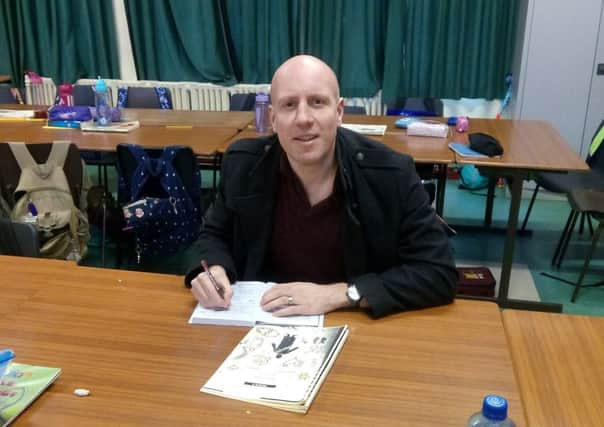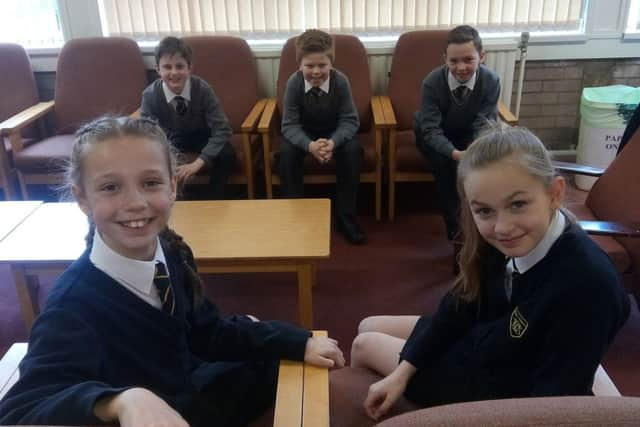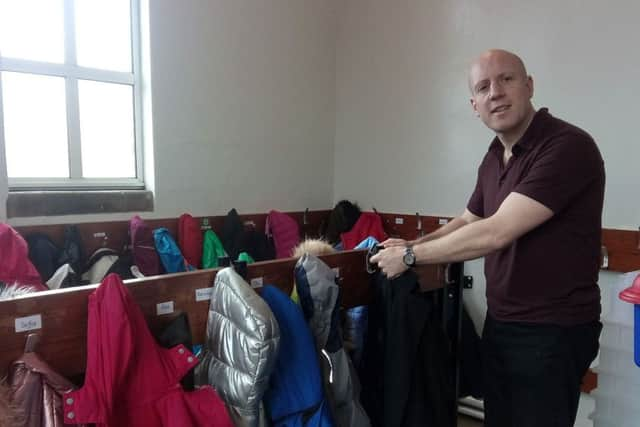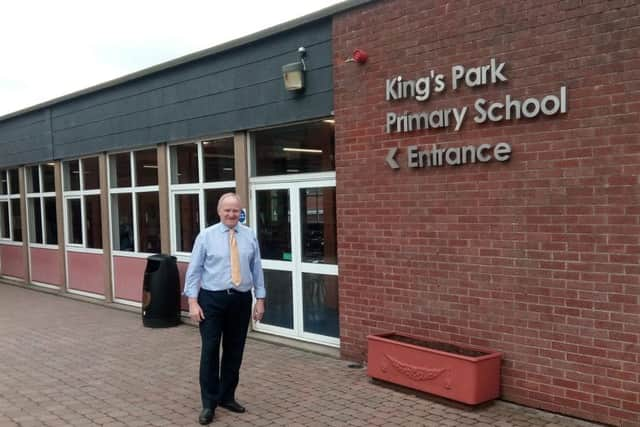News Letter reporter goes back to school after 30 years


Until I paid a visit to my old primary school last week it hadn’t occurred to me that three decades had passed since my last lesson there.
I’d come up with the idea of a ‘then and now’ feature on my old school in Lurgan before working out the last time I’d taken part in a winner-keeps-all game of marbles in the school playground was 1989.
Advertisement
Hide AdAdvertisement
Hide AdFinding out whether the King’s Park pupils of nowadays still played marbles was one of my objectives as well as identifying new trends that dominate the lives of primary school children.


To help me with my school project I met five 10-year-olds – all P6 pupils at King’s Park – Sophia Heasley, Alex Kerr, Freddy McTernaghan, Charlie Gault and Michael Robinson.
As we swapped stories about our school days past and present it was clear I was in a room of people who were on my level.
Lesson #1: Pocket money
I asked do parents still give pocket money?


Freddy explained: “I get 25p if I do a job around the house. I save it up to buy the Beano comic.”
Advertisement
Hide AdAdvertisement
Hide AdNot only was I impressed that this young man works hard for his pocket money, but I was also taken aback that the Beano is still going strong.
Sophia said that rather than get a set amount of pocket money, she sometimes gets spoiled when visiting her nanny’s house: “I’d get £10 to buy sweets which I know is far too much for sweets!”
I must admit, I was the same as Sophia, relying on the unconditional love of grandparents for the items I coveted. Mine had me spoiled rotten with football stickers and Star Wars figures.


In terms of spending the cash they accumulated – mostly from birthday and Christmas money – Charlie said he saved for football gear.
Lesson #2: Swap shop
Advertisement
Hide AdAdvertisement
Hide AdOne of my favourite activities at school was swapping football stickers with other collectors, but do football cards and stickers still get a look in with today’s 10-year-olds?
Michael said: “Some people collect Match Attax (football cards), but they’re a waste of money now. It’s a £1 for seven cards. You used to get 10.”
Charlie said: “You’re not allowed to bring them into school because people were bringing them out during class.”
I hold my hand up to being guilty of that particular crime.
Lesson #3: After school clubs
Thirty years ago there weren’t too many reasons to stay on after the bell rang – unless, like myself, your mum taught at the school and occasionally you would hang about in her classroom in order to get a lift home. Nowadays there are very few schools who don’t run after school activities.
Advertisement
Hide AdAdvertisement
Hide AdAlex listed some of the clubs at King’s Park: “We have football, netball, cross country, cricket, cookery, music lessons. I tried the cookery but I’m too sporty, I just can’t sit still.”
In addition to taking part in after school sports, most of the children were also members of sports clubs outside school and played at least one musical instrument.
Lesson #4: Screen time
Talking to these five outdoor enthusiasts, the often painted picture of young people as lazy, obese and console-obsessed couldn’t have seemed further from the truth.
I asked them if they were the exception to the rule, or if most of their classmates were like them.
Advertisement
Hide AdAdvertisement
Hide Ad“Anytime I’ve got free time I got out and play football,” said Charlie.
“I like playing sport and then reading books at night time,” said Alex.
“A lot of boys in my class talk about Fortnite (a video game) and it’s so annoying,” said Sophia.
The children estimated that in each of their P6 classes there were around five or six who were obsessed with video games and some had poor physical health possibly because of their gaming.
Advertisement
Hide AdAdvertisement
Hide AdAsked about screen time (time spent on tablets and phones), Charlie said: “I’ve got a screen time limit but during the week I never go over it. Maybe I would watch a bit of YouTube at weekends.”
Freddy said he thought having screen time was a good idea as it’s better to be outside than on a tablet.
Lesson #5: Toys
I began collecting toys when I was at school and never stopped. Now I have the added excuse of buying toys for my own children, who are in P2 and P3. I asked the children what toys they collected so I could get an idea of what floats a 10-year-old’s boat.
The unanimous answer brought a tear to my eye: “We’ve grown out of toys.”
Lesson #6: Books
I was pleased to learn they haven’t grown out of books.
Advertisement
Hide AdAdvertisement
Hide AdQuite the opposite. All of the children had a clear passion for reading, listing JK Rowling’s Harry Potter series and David Walliams’ books as their favourites.
Freddy said: “When we had World Book Day at the school my granddad thought it was Harry Potter Day because so many people dressed up as Harry Potter.”
Meanwhile Charlie bent the rules slightly by dressing up as Spurs and England striker Harry Kane: “He’s in a book (Kane: Ultimate Football Heroes), you’re allowed to dress up as anyone from a book.”
Lesson #7: Films and TV
This was an area where I was on an even footing with the kids. As a fan of Harry Potter, Star Wars and a regular viewer of Match of the Day I pretty much fit the profile of a 10-year-old.
Advertisement
Hide AdAdvertisement
Hide AdI listed a few programmes I’d have watched in my youth and was surprised to learn they’d heard of A-Team, He-Man and Scooby Doo, but then a lot of eighties classics have been resurrected or rebooted.
Lesson #8: Break time
It came as a big shock when the children told me that break time and lunch time is staggered for different year groups and classes, and the play areas – including the MUGA – are assigned to certain groups on certain days so that no one has a monopoly. It makes total sense but that’s not to say I didn’t love the frantic sprint to be the first on the pitch for a game of football that sometimes could have been 30-a-side.
Such is the school’s desire to get pupils active that King’s Park was one of the first schools in Northern Ireland to introduce a ‘daily mile’ scheme.
Since 2016 all its 750 pupils take to the multi-use games area (MUGA) to walk or run a mile every day.
Advertisement
Hide AdAdvertisement
Hide AdPrincipal Terry Shields said: “If anybody asks me what a school needs more than anything it’s a MUGA pitch that can be used all year round.
“Through the daily mile we’ve seen a big improvement in children’s behaviour and of course it’s good for their social and emotional wellbeing.”
Mr Shields explained how demand for the MUGA at break time and lunch time has meant extra organisation.
He said: “The MUGA pitch has revolutionised play and lunch time.
Advertisement
Hide AdAdvertisement
Hide Ad“Initially we had to stagger the lunches because not everyone could fit in the canteen.
“Then further organisation was needed so that everyone gets their turn on the MUGA.”
During my time at King’s Park there had been a grass football pitch at the bottom end of the school beside Lurgan Park and a tarmac hockey pitch which we used to play football on all year round.
Now the grass pitch has been replaced by the MUGA, though it was nice to see the hockey posts still standing.
Advertisement
Hide AdAdvertisement
Hide AdMr Shields said: “When you’d have been here there was a grass pitch which wasn’t used for six months of the year because it was wet and mucky. Now we have the children outdoors every day.
“We’re very much about getting them into the fresh air and getting them active.”
Lesson #9: The playground
I feared this would be the case, but apparently no one plays marbles anymore, nor conkers, nor are there any yo-yo experts performing tricks to mesmerised P1s and P2s.
Michael said: “We’re not allowed marbles or conkers or yo-yos because they’re too dangerous.”
Advertisement
Hide AdAdvertisement
Hide AdInstead the children said that they played team sports like handball and football during breaks, which to me sounded like break time had become an extension of PE.
Please tell me you still play chasing, I asked.
The answer was yes, though sadly British Bulldog has long been banished. A new ‘cat and mouse’ game called Infected sounded interesting.
Asked if the school had played a part in phasing out playground activities like marbles and conkers, the principal said: “Marbles aren’t banned, but you wouldn’t really see them about, the same as conkers.”
Lesson #10: School play
It would seem school productions have become a lot more ambitious in their story telling. King’s Park’s school play this year is Sleeping Beauty with a twist.
Advertisement
Hide AdAdvertisement
Hide AdFreddy explained: “Everyone only cares about themselves, the witch puts a spell on them and they fall asleep. There’s a show called Prince Factor, those taking part have to try to wake the sleeping people up with their talents.”
Lesson #11: Home time
Asked what was the first thing they did upon getting home, Sophia said: “I take out my shirt. It’s so annoying keeping it tucked in all day.”
After getting changed, the five children said they got their homework out of the way – usually taking between 15 and 30 minutes – so the rest of the day was their own.
Lesson #12: The best thing about school
Another unanimous answer: seeing your friends.
I’d never really thought about it myself until now, but I’d have to agree.
Advertisement
Hide AdAdvertisement
Hide AdOn reflection my days at King’s Park were pretty awesome and 30 years on I can really appreciate that sense of freedom and lack of stress. But I’m glad my school days happened in the 80s and not now – since schools have lost their marbles.